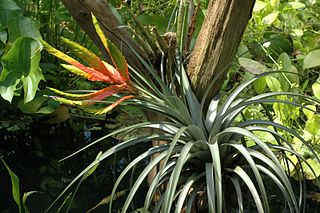
Tillandsioideae is a subfamily of plants in the bromeliad family Bromeliaceae. This subfamily contains the greatest number of species (1,277). Most are epiphytic or lithophytic, growing in trees or on rocks where they absorb water and nutrients from the air. Spanish moss of the Tillandsia genus is a well-known variety. Bromeliads in the genera Guzmania and Vriesea are the more commonly cultivated members of this subfamily.

Millettia is a genus of legume in the family Fabaceae. It consists of about 150 species, which are distributed in the tropical and subtropical regions of the world. The genus was formerly known by the name Pongamia, but that name was rejected in favor of the name Millettia, and many species have been reclassified. Due to recent interest in biofuels, Pongamia is often the generic name used when referring to Millettia pinnata, a tree being explored for producing biodiesel.

Kalanchoe pinnata, commonly known as cathedral bells, air plant, life plant, miracle leaf, and Goethe plant is a succulent plant native to Madagascar. It is a popular houseplant and has become naturalized in tropical and subtropical areas. The species is distinctive for the profusion of miniature plantlets that form on the margins of its phylloclades, a trait it has in common with some other members of Bryophyllum.
Hosackia pinnata, synonym Lotus pinnatus, is a species of legume native to western North America from British Columbia to California. It is known by the common names meadow bird's-foot trefoil and bog bird's-foot trefoil. Its distribution extends into British Columbia in just a few rare occurrences near Nanaimo. It grows in moist to wet habitat, such as bogs and spring meadows. It is a hairless perennial herb lined with leaves each made up of green oval leaflets each 1 to 2.5 centimeters in length. The inflorescence is an array of up to 10 pealike flowers between 1 and 2 centimeters long. Each flower has a bright yellow banner, or upper petal, and white lower petals. The fruit is a slender, elongated legume pod up to 5 centimeters long but just a few millimeters long.

Macrochordion is a subgenus of the genus Aechmea.

Platyaechmea is a subgenus of the genus Aechmea.
Tillandsia rohdenardinii is a species of flowering plant in the family Bromeliaceae, native to south Brazil. It was first described by Teresia Strehl in 2004.
Mezobromelia bicolor is a plant species in the family Bromeliaceae. This species is native to Ecuador and Colombia.

Mezobromelia capituligera is a plant species in the genus Mezobromelia. This species is native to West Indies and northern South America.
Mezobromelia pleiosticha is a species of flowering plant in the family Bromeliaceae. This species is native to northwestern South America.
Josemania truncata is a species of flowering plant in the family Bromeliaceae, native to Colombia and Ecuador. It was first described by Lyman Bradford Smith in 1954 as Tillandsia truncata. Plants of the World Online sinks the genus Josemania into Cipuropsis, treating this species as Cipuropsis truncata.
Cipuropsis amicorum is a species of flowering plant in the family Bromeliaceae, native to Venezuela. It was first described in 1990 as Tillandsia amicorum.
Josemania asplundii, synonym Tillandsia asplundii, is a species in the genus Josemania, native to Ecuador and Peru. It was first acquired by the 1842 United States Expedition in South America.
Josemania singularis, synonym Cipuropsis singularis, is a species of flowering plant in the family Bromeliaceae. This species is native to Costa Rica and Panama.

Ratibida pinnata is a species of flowering plant in the family Asteraceae known by the common names pinnate prairie coneflower, gray-head coneflower, yellow coneflower, and prairie coneflower. It is native to the central and eastern United States and Ontario in Canada.

Staphylea pinnata, the European bladdernut, is a species of bladdernut native to Europe and naturalized in Britain.
Cipuropsis is a genus of flowering plant in the family Bromeliaceae, native to the Caribbean, southern Central America and northwestern South America. The genus was first described by Ule in 1907.

Tillandsia subg. Tillandsia is a subgenus of the genus Tillandsia.
Josemania is a genus of flowering plant in the family Bromeliaceae, first described in 2016.
Josemania delicatula, synonym Cipuropsis delicatula, is a species in the family Bromeliaceae, native to Colombia.








